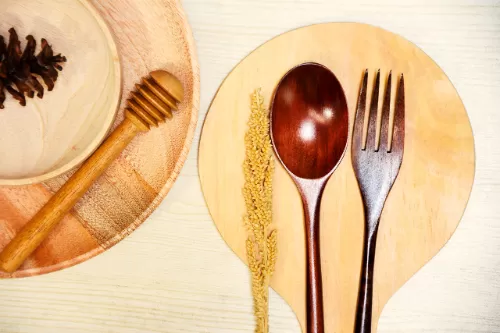6 Non Toxic Kitchen Utensils Chefs Actually Use and Love in Real Life
In kitchens across America, a quiet revolution is happening—people are ditching questionable plastics and chemical-laden tools in favor of clean, non-toxic kitchen utensils. And it's not just home cooks doing the swapping. Professional chefs, who spend hours every day prepping, tasting, and plating, are becoming strong advocates for safer, more sustainable tools made from materials like wood, stainless steel, ceramic, and glass.

If you've ever felt uneasy about that old plastic spatula melting on a hot pan or wondered whether your cutting board might be harboring more than just crumbs, this article is for you. We spoke with culinary pros and cooking enthusiasts to find out which non-toxic kitchen essentials they actually use—and recommend. Spoiler: these aren’t fancy gadgets collecting dust in drawers. They're workhorse tools designed to last.
Here are six non-toxic kitchen utensils that deserve a permanent spot in your cooking routine.
Ceramic Scraper Spatula
Let’s start with a surprising hero: the ceramic scraper spatula. Unlike traditional plastic or rubber spatulas that can warp over time or leach unknown substances when exposed to heat, high-quality ceramic options are naturally non-toxic and highly heat-resistant. They glide under baked goods with ease, scrape every last bit from mixing bowls, and won't discolor or absorb odors.
Chef Elena Vargas, a Los Angeles-based baker, swears by hers. “It’s the only spatula I trust when I’m working with chocolate or anything temperature-sensitive. Plus, it’s gorgeous—who knew a spatula could feel elegant?”
Oak Wood Cutting Board
While maple gets a lot of attention in cutting board circles, oak is having a quiet comeback. Hard, durable, and rich in natural antibacterial properties, oak cutting boards are a beautiful and functional alternative to their plastic counterparts. They’re ideal for everything from chopping vegetables to slicing bread—and let’s be honest, they look stunning on any countertop.
Chef Derek M., a private chef in Seattle, says, “I’ve stopped using plastic boards completely. My oak board handles everything from onions to steak, and it doesn’t get that weird greasy feel over time.”
The key? Regular oiling and care. Treat it right, and this board will last decades.
Glass Storage Containers with Silicone Lids
We all have that sad drawer full of mismatched plastic containers. It’s time to level up. Glass storage containers with silicone lids are not only more attractive and durable, but they also don’t stain, warp, or absorb smells the way plastic does.
These are great for meal preps, leftovers, and even baking. You can go straight from fridge to microwave or oven without worrying about toxins leaching into your food.
Chef Tanya B. explains, “I use glass containers to store sauces, chopped produce—even batter. You always know what’s inside at a glance, and there’s no mystery orange tint like you get with plastic.”
Stainless Steel Nesting Bowls
Let’s be real: every kitchen needs a solid set of mixing bowls. Stainless steel bowls are lightweight, unbreakable, and completely non-reactive, meaning they won’t mess with the taste of your food.
Nesting sets save space and come in sizes perfect for tossing a salad, mixing dough, or marinating meat. And unlike plastic, you can toss them in the dishwasher again and again without worrying about warping or scratching.
Chef Ian, who travels with his own toolkit, puts it this way: “If I show up to a job and there’s no stainless steel bowl, I feel naked. It’s the one tool I know I can rely on for literally any task.”
Natural Bristle Basting Brush with Wooden Handle
The humble basting brush often gets overlooked, but it plays a huge role in flavor and presentation. Instead of synthetic options, chefs are turning to natural bristle brushes with wooden handles for everything from glazing pastries to coating meats in marinade.
These brushes don’t melt on hot pans, and they hold sauces better, offering more control and coverage. Plus, they’re easy to clean and don't develop the funky smell that often plagues synthetic brushes.
Pro tip: Look for untreated wood and avoid brushes with mystery coatings or glues.
Silicone Ice Cube Tray with Lid
Last but not least, let’s talk about ice. Yes, ice. Those hard plastic trays from decades past have been replaced by flexible, food-grade silicone versions that make popping out cubes a breeze—no twisting or banging required.
Why does this matter? If you’re using ice in drinks, smoothies, or food prep, you want it clean and flavor-neutral. Many silicone trays come with lids, so your cubes don’t absorb freezer odors or spill when you’re juggling space.
Chef Maya says, “I use mine not just for ice, but also for freezing stocks, sauces, and even herbs in olive oil. It’s an easy way to avoid waste and keep flavors fresh.”
Why Non Toxic Matters in the Kitchen
Many cooks are becoming more conscious of what goes into their bodies—and that extends beyond ingredients to the tools they use. BPA, phthalates, and mystery plastics have raised red flags, prompting a return to materials we can trust.
When you switch to non-toxic kitchen tools, you’re making a long-term investment in your health and your cooking experience. Food tastes better, prep feels smoother, and you don’t have to second-guess every melted corner or scratched surface.
Plus, these materials—wood, glass, ceramic, and stainless steel—tend to age gracefully. They’re not only safer, but also more beautiful and sustainable.
Conclusion
You don’t need to throw everything out and start from scratch. Begin with one or two upgrades—maybe swap your old plastic spatula for a ceramic one, or trade your cutting board for a sleek oak version. Over time, you’ll build a kitchen setup that’s healthier, more efficient, and just more fun to use.

